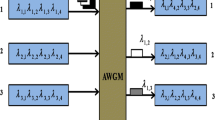Abstract
For the next generation of the optical internet, focus is now moving from circuit switched networks, which occupy a wavelength continuously regardless of the demand at that time, towards optical packet/burst switching. By only occupying a wavelength when data is to be transmitted, a more efficient utilization of bandwidth in optical fibers is strived for. As bandwidth in fibers keeps increasing, the bottleneck of the optical network is now moving towards the switching node, since evolution of electronic routers cannot follow the speed of bandwidth increase. Thus a key component in these novel networks is the optical node. Through this node we want to switch traffic very fast and reliably, preferably transparent. Lack of efficient and practically realizable optical buffer, however, makes migration from electronic routers to optical routers a non-straightforward transition. In most optical nodes payload traffic can be switched transparently, whilst control information (e.g., in a header, on a control channel) is still converted to the electronic domain in every node, since optical processing is far from mature. In this paper we present a possible architecture for such a node, array waveguide gratings and all-optical tuneable wavelength converters. The concept of this switch is explained and the node is evaluated in terms of loss rate. We will see that an inherent problem of this switch is its internal blocking. This drawback can be greatly overcome by using an intelligent and efficient wavelength assignment algorithm within the node. Simulation of slotted operation will give some numerical results.
Similar content being viewed by others
References
N. Wauters, P. Demeester, Design of the optical path layer in multiwavelength cross-connected networks, IEEE J. on Sel. Areas in Comm., vol. 14,no. 5, (June 1996), pp. 881-892.
D. Colle et al., Data-centric optical networks and their survivability, IEEE J. on Sel. Areas in Comm., vol. 20,no. 1, (January 2002), pp. 6-20.
P. Gambini et al., Transparent optical packet switching: network architecture and demonstrators in the KEOPS project, IEEE J. on Sel. Areas in Comm., vol. 16,no. 7, (Sept. 1998), pp. 1245-1259.
M. O'Mahony et al., An optical packet switched network (WASPNET)-concept and realisation, Optical Networks Mag., vol. 2,no. 6, (November/December 2001), pp. 46-53.
C. Qiao, M. Yoo, Optical Burst Switching (OBS)—A New Paradigm for an Optical Internet, J. High Speed Networks (JHSN) on WDM Networks, vol. 8,no. 1, (January 1999), pp. 69-84.
M. Yoo, C. Qiao, S. Dixit, QoS Performance of Optical Burst Switćhing in IP-over-WDM Networks, IEEE J. on Sel. Areas in Comm., vol. 18,no. 10, (October 2000), pp. 2062-2071.
M. Düser, P. Bayvel, Performance of a dynamically wavelength-routed optical burst switched network, IEEE Phot. Techn. Lett., IEEE Photonics Technology Letters, vol. 14, no. 2, (Feb. 2002), pp. 239-241.
C. R. Giles, et al., A silicon MEMS optical switch attenuator and its use in lightwave subsystems, IEEE J. of Sel. Topics in Quantum Electronics, vol. 5,no. 1, (January/February 1999), pp. 18-25.
S. De Maesschalck et al., Intelligent optical networking for multilayer survivability, IEEE Commun. Mag., vol. 40,no. 1, (January 2002), pp. 42-49.
L. Zuchelli, M. Burzio, P. Gambini, New solutions for optical packet delineation and synchronisation in optical packet switched networks, Proc. Europ. Conf. On Opt. Comm. 1996, (Oslo, Norway, September 1996), vol. 3, pp. 301-304.
T. Koonen, G. Morthier, J. Jennen, H. de Waardt, P. Demeester, Optical packet routing in IP-over-WDM networks deploying two-level optical labeling, Proc. of Europ. Conf. On Opt. Comm. 2001, (Amsterdam, The Netherlands, October 2001), vol. 4, pp. 608-609.
S. Yao, B. Mukherjee, S. Dixit, Advances in photonic packet-switching: An overview, IEEE Comm. Mag., vol. 38,no. 2, (February 2000), pp. 84-93.
K. Stubkjaer, Semiconductor optical amplifier-based all-optical gates for high speed optical processing, IEEE J. of Sel. Topics in Quantumel, vol. 6,no. 6, (November/December 2000), pp. 1428-1435.
D. Cotter, A. D. Ellis, Asynchronous digital regeneration and networks, J. Lightwave Techn., vol. 16,no. 12, (December 1998), pp. 2068-2080.
M. K. Smit, C. van Dam, Phasar-based WDM devices: principles, design and applications, IEEE J. Sel. Topics Quantum Electronics, vol. 2, (June 1996), pp. 236-250.
D. Wolfson et al., 40 Gb/s all-optical wavelength conversion, regeneration and demultiplexing in an SOA-based all-active Mach-Zehnder interferometer, IEEE Phot. Techn. Lett., vol. 12, (March 2000), pp. 332-334.
G. Chartrand, O. P. Oellermann, Applied and Algorithmic Graph Theory, (Mc Graw-Hill, New York, 1975), pp. 161-204.
Author information
Authors and Affiliations
Rights and permissions
About this article
Cite this article
Cheyns, J., Develder, C., Van Breusegem, E. et al. Routing in an AWG-Based Optical Packet Switch. Photonic Network Communications 5, 69–80 (2003). https://doi.org/10.1023/A:1021005913665
Issue Date:
DOI: https://doi.org/10.1023/A:1021005913665



